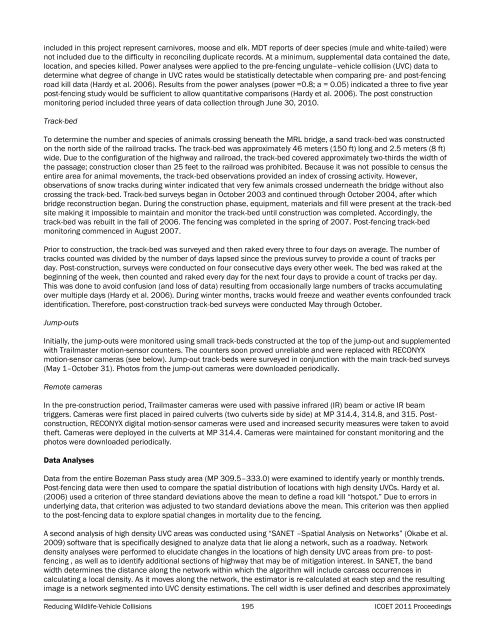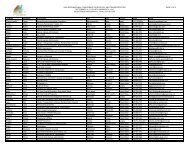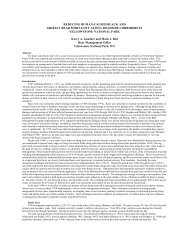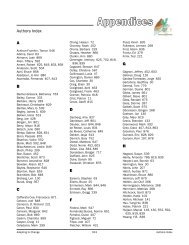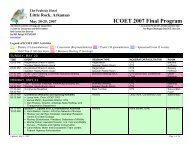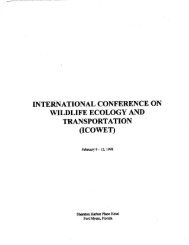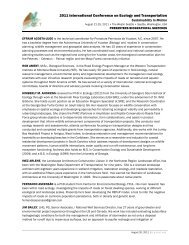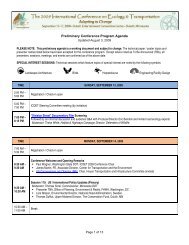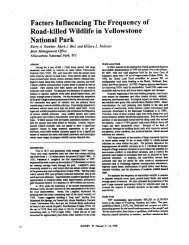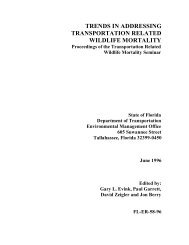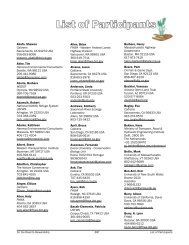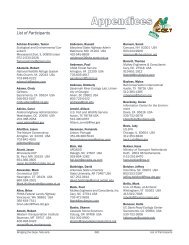COM-1, pages 179-226 - ICOET
COM-1, pages 179-226 - ICOET
COM-1, pages 179-226 - ICOET
You also want an ePaper? Increase the reach of your titles
YUMPU automatically turns print PDFs into web optimized ePapers that Google loves.
included in this project represent carnivores, moose and elk. MDT reports of deer species (mule and white-tailed) werenot included due to the difficulty in reconciling duplicate records. At a minimum, supplemental data contained the date,location, and species killed. Power analyses were applied to the pre-fencing ungulate–vehicle collision (UVC) data todetermine what degree of change in UVC rates would be statistically detectable when comparing pre- and post-fencingroad kill data (Hardy et al. 2006). Results from the power analyses (power =0.8; a = 0.05) indicated a three to five yearpost-fencing study would be sufficient to allow quantitative comparisons (Hardy et al. 2006). The post constructionmonitoring period included three years of data collection through June 30, 2010.Track-bedTo determine the number and species of animals crossing beneath the MRL bridge, a sand track-bed was constructedon the north side of the railroad tracks. The track-bed was approximately 46 meters (150 ft) long and 2.5 meters (8 ft)wide. Due to the configuration of the highway and railroad, the track-bed covered approximately two-thirds the width ofthe passage; construction closer than 25 feet to the railroad was prohibited. Because it was not possible to census theentire area for animal movements, the track-bed observations provided an index of crossing activity. However,observations of snow tracks during winter indicated that very few animals crossed underneath the bridge without alsocrossing the track-bed. Track-bed surveys began in October 2003 and continued through October 2004, after whichbridge reconstruction began. During the construction phase, equipment, materials and fill were present at the track-bedsite making it impossible to maintain and monitor the track-bed until construction was completed. Accordingly, thetrack-bed was rebuilt in the fall of 2006. The fencing was completed in the spring of 2007. Post-fencing track-bedmonitoring commenced in August 2007.Prior to construction, the track-bed was surveyed and then raked every three to four days on average. The number oftracks counted was divided by the number of days lapsed since the previous survey to provide a count of tracks perday. Post-construction, surveys were conducted on four consecutive days every other week. The bed was raked at thebeginning of the week, then counted and raked every day for the next four days to provide a count of tracks per day.This was done to avoid confusion (and loss of data) resulting from occasionally large numbers of tracks accumulatingover multiple days (Hardy et al. 2006). During winter months, tracks would freeze and weather events confounded trackidentification. Therefore, post-construction track-bed surveys were conducted May through October.Jump-outsInitially, the jump-outs were monitored using small track-beds constructed at the top of the jump-out and supplementedwith Trailmaster motion-sensor counters. The counters soon proved unreliable and were replaced with RECONYXmotion-sensor cameras (see below). Jump-out track-beds were surveyed in conjunction with the main track-bed surveys(May 1–October 31). Photos from the jump-out cameras were downloaded periodically.Remote camerasIn the pre-construction period, Trailmaster cameras were used with passive infrared (IR) beam or active IR beamtriggers. Cameras were first placed in paired culverts (two culverts side by side) at MP 314.4, 314.8, and 315. Postconstruction,RECONYX digital motion-sensor cameras were used and increased security measures were taken to avoidtheft. Cameras were deployed in the culverts at MP 314.4. Cameras were maintained for constant monitoring and thephotos were downloaded periodically.Data AnalysesData from the entire Bozeman Pass study area (MP 309.5–333.0) were examined to identify yearly or monthly trends.Post-fencing data were then used to compare the spatial distribution of locations with high density UVCs. Hardy et al.(2006) used a criterion of three standard deviations above the mean to define a road kill “hotspot.” Due to errors inunderlying data, that criterion was adjusted to two standard deviations above the mean. This criterion was then appliedto the post-fencing data to explore spatial changes in mortality due to the fencing.A second analysis of high density UVC areas was conducted using “SANET –Spatial Analysis on Networks” (Okabe et al.2009) software that is specifically designed to analyze data that lie along a network, such as a roadway. Networkdensity analyses were performed to elucidate changes in the locations of high density UVC areas from pre- to postfencing, as well as to identify additional sections of highway that may be of mitigation interest. In SANET, the bandwidth determines the distance along the network within which the algorithm will include carcass occurrences incalculating a local density. As it moves along the network, the estimator is re-calculated at each step and the resultingimage is a network segmented into UVC density estimations. The cell width is user defined and describes approximatelyReducing Wildlife-Vehicle Collisions 195 <strong>ICOET</strong> 2011 Proceedings


